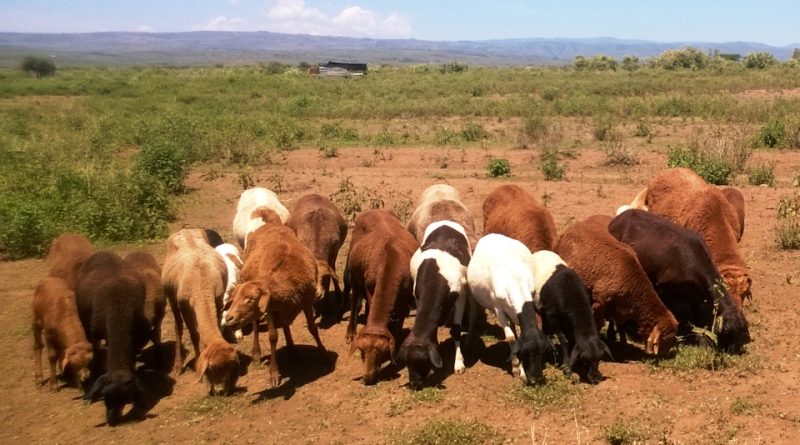Red Masai sheep
Red Masai sheep
The Masai or Tanganyika red sheep (Ovis aries Linnaeus, 1758) is a native East African breed for meat production.
Systematic –
From a systematic point of view it belongs to:
Eukaryota domain,
Kingdom Animalia,
Phylum Chordata,
Mammalia class,
Order Artiodactyla,
Suborder Ruminantia,
Bovidae family,
Subfamily Caprinae,
Genus Ovis,
Species O. aries,
Masai red breed.
Geographical and Areal Distribution –
The Masai Red Sheep is a breed of sheep that can be found in southern Kenya, northern Tanzania and some areas of Uganda, in arid and semi-arid regions along the Great Rift Valley.
Today it is found predominantly in Kenya in the Kajiado district and surrounding area, but before the 20th century it was farmed in a much larger region that included the wetlands of the Kenyan highlands, areas northeast of the Great Rift Valley, and the once marshy areas of the central-southern highlands.
Origins and History –
The Masai red sheep or Tanganyika is an indigenous breed traditionally bred by the Masai community.
Unfortunately, the land of the Maasai has been under pressure for some time. This land is taken away from herders and often sold to other groups or private investors. The land intended for grazing is reduced, the indigenous community is forced to move and often suffers acts of violence. Added to this are recurring droughts, a consequence of climate change, and the flight of young people to the cities. Furthermore, since 1970, the country’s agricultural policy has promoted crossbreeding of the red Masai sheep with the Dorper and other imported sheep and today it is increasingly rare to find pure-bred sheep.
For this reason, saving this breed is essential to preserve a genetic resource and to protect a resilient animal, capable of surviving diseases and the consequences of climate change.
This breed is a presidium in collaboration between Slow Food and IFAD (International Fund for Agricultural Development) and has, among its objectives, the strengthening of the Maasai community through training activities, technical assistance, exchanges of experiences, creation of market outlets , with a particular focus on the inclusion of women and young people. Furthermore, the Maasai community will be involved in the national and international activities of the Terra Madre Indigenous network (a platform for exchanging and sharing experiences, which helps indigenous people to work together and find solutions to common problems together).
Morphology –
The red Masai or Tanganyika sheep can be recognized by its fat tail and the thick down that covers it instead of wool: red is the most common colour, however brown animals can also be found and, sometimes, with piebald coats.
It is a relatively large sheep, although they are rather stocky (the height of the males is just 73 cm and the weight reaches 45 kg, while the females are on average 62 cm tall and weigh 35 kg).
Productive attitude –
The red Masai is a rather rustic sheep and is capable of surviving various local parasites (such as Haemonchus contortus) and long periods of drought. With their pest and drought resistant qualities, Maasai red sheep represent an important breed that can continue to improve food security in communities.
A traditional belief says that the rain god entrusted the livestock to the Masai when Earth and Sky were divided and, again according to legend, the red Masai sheep was the first animal chosen by the community.
It is raised in the wild mainly for meat and represents an important food for the food security of communities.
The Masai wait until the sheep are at least 12 months old before slaughtering them. The meat can be roasted or boiled and is consumed all year round, but in particular during ceremonies such as weddings and initiations. According to a traditional belief, the rain god entrusted the livestock to the Masai when Earth and Sky were divided and, again according to legend, the red Masai sheep was the first animal chosen by the community for breeding.
Unfortunately, the reduction of land available for grazing due to increasing subdivisions has forced some Maasai to dedicate themselves to subsistence cultivation. This has led to a reduction in the number of animals and food available and at the same time has decreased the possibility of selling livestock in exchange for money or other animals or products (such as milk).
The red Maasai sheep has not been bred internationally due to its small stature and the down that covers the animal instead of wool.
This was the predominant sheep breed among the Maasai and other communities in Kenya until the 1970s, when subsidies began to support crossbreeding with Dorper and other imported sheep. Today crossbreeds are the majority, and purebred sheep are less common, making the future of the animal uncertain. The protection of the Masai red sheep is essential to safeguard genetic resources.
Guido Bissanti
Fonti-
– Wikipedia, l’enciclopedia libera.
– Balasini Dialma, 2001. Zootecnica applicata. Ovicaprini. Pecore e capre. Per gli Ist. tecnici e professionali, Caledrini Edagricole, Bologna.
– Daniele Bigi, Alessio Zanon, 2010. Atlante delle razze autoctone. Bovini, equini, ovicaprini, suini allevati in Italia, Edagricole-New Business Media, Bologna.

